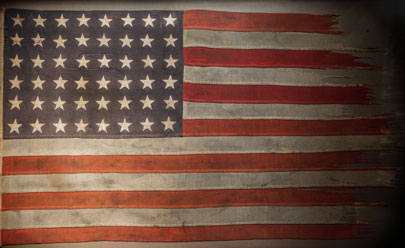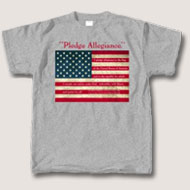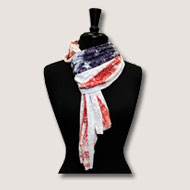FOCUS ON: STARS AND STRIPES
The American Flag
The collection of The National WWII Museum contains numerous American flags of many varieties from battle-tested flags flown from vessels during Pacific Island invasions to American flags handmade by French teenagers in anticipation of the Allied arrival. The American flag stands as one of the most evocative symbols of freedom and democracy. During WWII, the American flag inspired millions at home and abroad and the sight of the Stars and Stripes being raised around the world became one of the most memorable events in the lives of many.
Spotlight on Bandleader Frank Rosato
Frank Rosato, trumpeter from New Orleans, Louisiana was referred to as “old man” at thirty years old by the younger band he commanded, the military band of the 156th Infantry Regiment, the Louisiana National Guard. Rosato’s band had been performing in London for years, even before the Royal Family, and were prepared to be sent home after V-E Day, but they delayed that event when asked to perform at the Potsdam Conference, the Allied summit conference from 17 July – 2 August 1945. Following the conference, the band headed after Truman to Berlin and played the National Anthem as the flag was raised over US Headquarters. The very same flag had flown over the Capitol during Pearl Harbor and the US declaration of war. The flag referred to as the Flag of Liberation had been raised over the vanquished Axis capitals. Soon it would fly over Tokyo. Rosato said that even beyond Potsdam, the highpoint of his career was playing the Star Spangled Banner in Berlin. He said, “When I directed the ‘Star Spangled Banner’ that day my hair stood straight up. Oh yes. That was a very, very strong feeling. I was very, very satisfied. Proud. Yes, indeed. I felt the heartbeat of everybody in the band. It was a very solemn occasion when that flag went up. I don’t think that we ever played the ‘Star Spangled Banner’ any better.” Rosata’s story can be read in War Stories: Remembering World War II by Elizabeth Mullener.
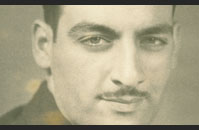 Chief Warrant Officer Frank Rosato.
Chief Warrant Officer Frank Rosato.
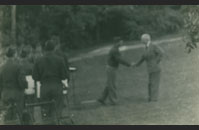 Rosato shaking hands with President Truman during the Potsdam Conference.
Rosato shaking hands with President Truman during the Potsdam Conference.
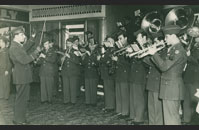 Rosato and band performing in London.
Rosato and band performing in London.
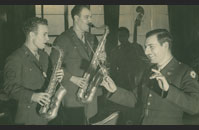 Rosato and band performing in London.
Rosato and band performing in London.
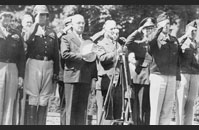 President Harry S. Truman salutes during the playing of the National Anthem during the raising of the flag of liberation in Berlin, Germany. The flag flew over the Capitol in Washington on December 7, 1941 and was raised in Rome on the day of its liberation, July 4, 1944.
President Harry S. Truman salutes during the playing of the National Anthem during the raising of the flag of liberation in Berlin, Germany. The flag flew over the Capitol in Washington on December 7, 1941 and was raised in Rome on the day of its liberation, July 4, 1944.
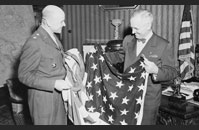 Major General Floyd L. Parks presented the Flag of Liberation to President Harry S. Truman in Berlin, Germany. President Truman is in Germany to attend the Potsdam Conference. The Flag of Liberation flew over the capitols of the axis powers. 23 July 1945.
Major General Floyd L. Parks presented the Flag of Liberation to President Harry S. Truman in Berlin, Germany. President Truman is in Germany to attend the Potsdam Conference. The Flag of Liberation flew over the capitols of the axis powers. 23 July 1945.
Spotlight on Merchant Seaman Murray Blum
Lt. Murray Blum served with the United States Merchant Marine (USMM) and was the chief radio operator aboard the SS Leonidas Polk. On December 3, 1943, sailing in the North Atlantic, the Leonidas Polk collided with another ship in its convoy, which sank immediately. Blum dove overboard and swam towards the voice of a survivor calling out for help. Blum’s body washed up on the shores of Scotland three weeks later. He was buried in Cambridge, England. His death changed his family forever.
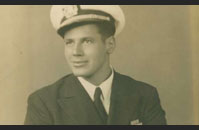 Photograph of Murray M. Blum in his United States Merchant Marine uniform. Location unknown. 1940s.
Photograph of Murray M. Blum in his United States Merchant Marine uniform. Location unknown. 1940s.
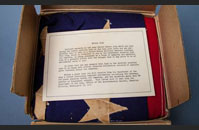 Photograph of the Murray M. Blum flag.
Photograph of the Murray M. Blum flag.
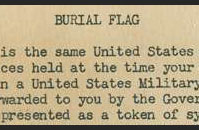 Burial flag message that was enclosed in the box with Blum’s burial flag.
Burial flag message that was enclosed in the box with Blum’s burial flag.
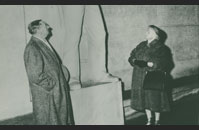 Murray Blum’s parents visiting the Cambridge American Cemetery in 1958.
Murray Blum’s parents visiting the Cambridge American Cemetery in 1958.
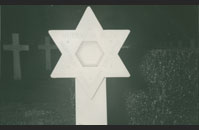 Murray Blum’s grave in the Cambridge American Cemetery.
Murray Blum’s grave in the Cambridge American Cemetery.
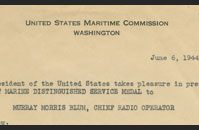 Citation for the Merchant Marine Distinguished Service Medal awarded to Murray Blum dated 6 June 1944.
Citation for the Merchant Marine Distinguished Service Medal awarded to Murray Blum dated 6 June 1944.
Educational Lesson Plans:
How can flags tell us stories about the past? Along with photographs and personal letters, flags and even a painting can be primary sources that teach us about the history of WWII. Explore three flags from the Museum’s collections, and learn how to “read” a painting by internationally known New Orleans artist Willie Birch with these two recommended lesson plans from The National WWII Museum.
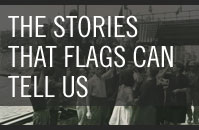

Learn how flags are primary sources about US military service in WWII. (Grades 6 – 8) |
Analyze a painting to learn more about the experiences of WWII veterans. (Grades 9 – 12) |
|
Additional Links:
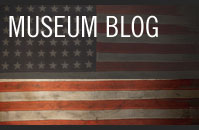

Read posts related to the American flag from our blog. |
See images from our collection featuring the American flag. |
|
Retail:
|
Pledge of Allegiance Flag Tee |
Sublimated Flag Scarf |
Glitter Flag Mug |

